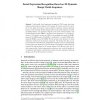112
click to vote
ECCV
2004
Springer
15 years 5 months ago
2004
Springer
Abstract. There is a growing trend toward emotional intelligence in humancomputer interaction paradigms. In order to react appropriately to a human, the computer would need to have...
122
click to vote
FGR
2006
IEEE
15 years 6 months ago
2006
IEEE
Traditionally, human facial expressions have been studied using either 2D static images or 2D video sequences. The 2D-based analysis is incapable of handing large pose variations....
122
click to vote
ECCV
2008
Springer
16 years 2 months ago
2008
Springer
Traditionally, facial expression recognition (FER) issues have been studied mostly based on modalities of 2D images, 2D videos, and 3D static models. In this paper, we propose a sp...
123
click to vote
CVPR
2006
IEEE
16 years 2 months ago
2006
IEEE
The creation of facial range models by 3D imaging systems has led to extensive work on 3D face recognition [19]. However, little work has been done to study the usefulness of such...
CVPR
2006
IEEE
16 years 2 months ago
2006
IEEE
In this paper, we propose a sequential approach to hallucinate/synthesize high-resolution images of multiple facial expressions. We propose an idea of multi-resolution tensor for ...

